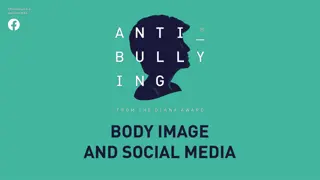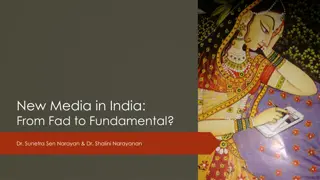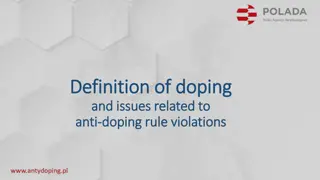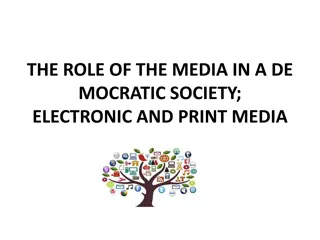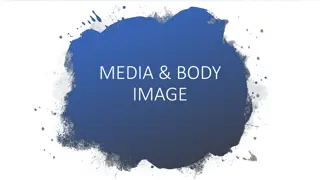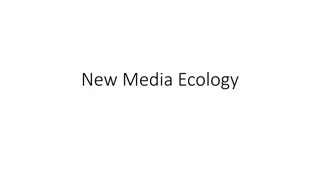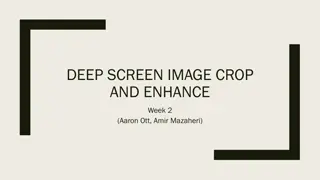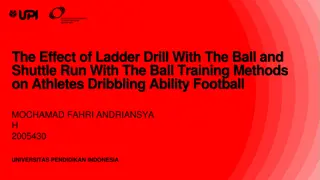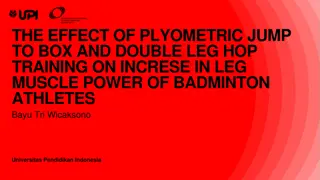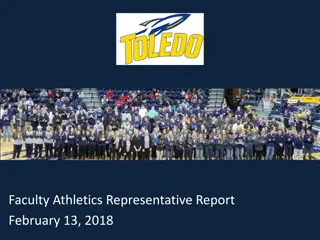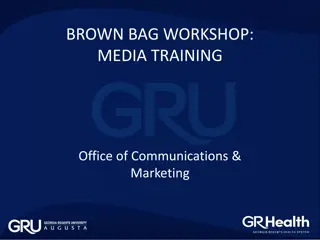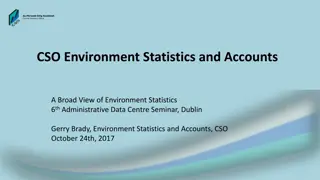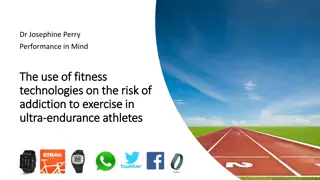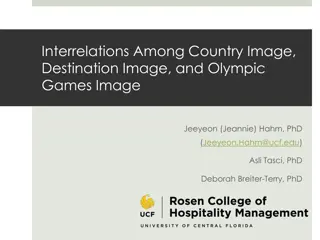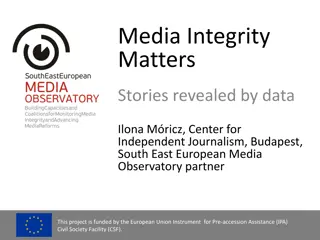Athletes' Image Repair Strategies: A Study on Media Accounts Following Violations
Investigating how professional athletes utilize personal accounts as an image repair strategy after facing violations. The study delves into trends, variables affecting strategies, and the importance of public image for athletes. Key theoretical foundations include Image Restoration Theory and Accounts Theory, providing insight into communication goals and reputation maintenance. Account types such as excuses, justifications, and denials are explored within the context of athletes managing their public image.
Download Presentation

Please find below an Image/Link to download the presentation.
The content on the website is provided AS IS for your information and personal use only. It may not be sold, licensed, or shared on other websites without obtaining consent from the author.If you encounter any issues during the download, it is possible that the publisher has removed the file from their server.
You are allowed to download the files provided on this website for personal or commercial use, subject to the condition that they are used lawfully. All files are the property of their respective owners.
The content on the website is provided AS IS for your information and personal use only. It may not be sold, licensed, or shared on other websites without obtaining consent from the author.
E N D
Presentation Transcript
+ I m Sorry For Letting You Down: A Study Into The Accounts To The Media By Professional Athletes Following A Violation Dr. Laith Zuraikat
+Purpose of the Study To examine the image repair strategies employed by athletes following a violation Specifically, the use of accounts as an image repair strategy Overarching questions What trends/patterns emerge? Do certain variables affect the repair strategy?
+Why Does This Matter? Highly visible segment of the population Media/public are interested in personal and professional lives of athletes Very influential group (role models) Personal and professional success is closely tied to their public image Previous Image Restoration research has focused on organizational responses Previous Accounts Theory research has focused on individuals (usually convicted criminals)
+Key Theoretical Foundations Benoit (1995) Image Restoration Theory Based on two key assumptions 1. Communication is a goal-directed activity 2. One of the key goals of communication is to assist with the maintenance of a positive reputation
+Key Theoretical Foundations Scott & Lyman (1968) - Accounts Theory Accounts are an image restoration strategy Accounts are narratives provided by violators in their efforts to manage image damage Developed an Accounts typology
+Account Definition A statement made by a social actor to explain unanticipated or untoward behavior (Scott & Lyman, 1968, p. 46). Form of talk discourse Helps to relieve cognitive dissonance/repair image Three main types Excuses Justifications Denials
+Account Types Excuse Excuses are accounts in which one admits that the act in question is bad, wrong, or inappropriate but denies full responsibility (Scott & Lyman, 1968, p. 47). Justifications - Justifications are accounts in which one accepts responsibility for the act in question, but denies the pejorative quality associated with it (Scott & Lyman, 1968, p. 47). Denial - The actor denies wrong-doing, or refuses to accept responsibility for the violation committed
+Justification Subtypes Denial of Injury Acknowledges that the person did a particular act but asserts that it was permissible to do that act since no one was injured by it, no one of importance in the community was injured, or the consequences were minor. Denial of Victim The action was permissible because the victim deserved the injury (Scott & Lyman, 1968, p. 51) Condemnation of Condemner A person admits doing what they were accused of but asserts that their actions was irrelevant because others have done the same or worse, and are either not caught, not punished, not condemned, unnoticed, or even praised. (Scott & Lyman, 1968, p. 51). Appeal to Loyalties Asserts that the action was permissible or even right since it served the interests of another to whom the person owes an unbreakable allegiance or affection (Scott & Lyman, 1968, p. 51). Sad Tales A selected (often distorted) arrangement of facts that highlight an extremely dismal past, and thus "explain" the individual's present state (Scott & Lyman, 1968, p. 52). Self-fulfillment The person does not find anything wrong with their action. Rather it is society, the accuser, or other members of society who are in the wrong and need to be enlightened.
+Excuse Subtypes Appeal to Accidents Claims that an accident was the source of the conduct. Attempts to mitigate responsibility by pointing to accepted physical and environmental hazards. Appeal to Defeasibility Claims that an individual was not fully informed, or that their will was not free. Attempts to excuse responsibility by claiming that if the individual had certain information available they would have altered their behavior Appeal to Biological Drive Claims that because the body and its biological behavior are always present but not always accounted for in science or society, invocation of the body and its processes is available as an excuse Hence, biological drives may be credited with influencing or causing at least some of the behavior for which actors wish to relieve themselves of full responsibility (Scott & Lyman, 1968, p. 49). Scapegoating Using this form a person will allege that his questioned behavior is a response to the behavior or attitudes of another (Scott & Lyman, 1968, p. 50).
+Key Variables Image Repair Strategy (Account Types) Excuses Justifications Denials Violation Type Legal Professional
+Key Variables Account Source Athlete Athlete Representatives Team Representatives Leagues National Football League (NFL) Major League Baseball (MLB) National Basketball Association (NBA)
+Account Types/Subtypes Justifications Excuses Denial of Injury Appeal to Accidents Denial of Victim Appeal to Defeasibility Appeal to Loyalties Appeal to Biological Drive Sad Tales Scapegoating Self-Fulfillment Condemnation of Condemner
+Multiple vs Single Account Usage Some athletes used a single type of account (sometimes repeated multiple times in different forms) in their statements Other athletes used multiple different types of accounts throughout their statements
+Potential Account Combinations Excuse Only Justification Only Denial Only Excuse and Justification Excuse and Denial Justification and Denial Excuse, Justification, and Denial
+Study Design Quantitative content analysis of the accounts provided by professional athletes Collected accounts from athletes in three leagues National Football League (NFL) National Basketball Association (NBA) Major League Baseball (MLB) Collected accounts from a one-year period (June 2018 June 2019)
+Results Descriptive Data Total Cases 158 League with the most cases NFL (88) Total Accounts 265 League with the most accounts - NFL (148) Violations Professional - 115 Legal 43
+Account Breakdown by League League Total Excuses Justifications Denials Accounts NFL 148 74 (50%) 61 (41%) 13 (9%) NBA 62 31 (50%) 25 (40%) 6 (10%) MLB 55 29 (53%) 20 (36%) 6 (11%) Total 265 134 (51%) 106 (40%) 25 (9%)
+Research Question 1 Research Question 1: Does the type of violation impact the use of accounts? Different violations carry different levels of social stigma So do certain types of violations produce common types of accounts?
+Hypotheses 1.1 Results H1.1: There will be a significant association between the type of account provided and the type of violation committed. Not Confirmed No significant association between the variables of account type and violation type Two most common types of accounts used for both legal and professional violations: Excuse only Justification only
+Hypotheses 1.2 Results H1.2 There will be a significant association between the type of violation committed and the source of the account provided. Confirmed There is a significant association between the variables of violation type and account source 71.3% of professional violations resulted in an account provided by the athlete. 20.9% of legal violations resulted in an account provided by a representative of the athlete.
+Research Question 2 Research Question 2: What impact does the league that the athlete is playing in have on the use of accounts by professional athletes? Different leagues garner different levels of public attention and media visibility Is there any connection between the league the athlete plays in, and the type(s) of account that is provided?
+Hypotheses 2 Results H2: There will be a significant association between the type of account provided and the league that the athlete plays in. Not Confirmed There is no significant association between the variables of account type and league NFL & NBA All 7 account combinations were used at least once. MLB 6 of the 7 possible account combinations were used at least once.
+Research Question 3 Research Question 3: Does the source of the account impact the type of account provided? The goal of image repair strategies are to help to mitigate/repair damage that has been done to an individual s reputation Individuals craft these strategies based on their goals/desires Does who is providing the account impact the use of account(s)?
+Hypotheses 3 Results H3: There will be a significant association between the type of account provided and the source providing the account. Confirmed There is a significant association between the variables of account type and account source 100% of the justification & denial account type were provided by athletes 40% of the excuse & denial account type were provided by representatives of the athlete
+Research Question 4 RQ4: Is there a difference in the types of account provided to the media by professional athletes following a violation? There are many different types of accounts which can be employed as well as numerous motivations for choosing a type of account Is there a specific type of account that is used more than others? What is the distribution of the different types of accounts?
+Hypotheses 4 Results H4: There will not be an even distribution of the types of accounts provided to the media by professional athletes. Confirmed Null hypothesis of a normal distribution of account types was rejected. The distribution of the account types in the data is not normal/even. Expected number of uses of each account type in a normal distribution was 22.6 uses of each type of account This was not the case
+Key Findings/Results Most common type of account employed was an Excuse Athlete accepts blame but attempts to explain why The most common sub type of Justification employed was an appeal to loyalty This often came in the form of an apology for letting down the athletes, team, teammates, and/or fans Majority of violations (72.28%) in all three leagues were professional in nature Athletes (69.96%) were the most common source of an account Possibly because this allows the athlete to craft their own story/image repair strategy
+Key Findings/Results Results of RQ1 seem to indicate that despite the potential differences in the perceived (or actual) severity between a professional and legal violation, there was not a common response given for a certain type of violation Results of RQ1 seem to suggest there is no common response template that athletes call upon when attempting to respond to the damage done by a specific type of violation There is an association between the violation type and the account source. The main driver for this result is most likely the association between legal violations and responses from an official representative of the athlete
+Key Findings/Results Based on the results of RQ2 it appears the sport the athlete participates in does not have a major impact on the type of account employed The lack of a strong association between account type and league type seems to indicate the differing amounts of media visibility does not have a major connection or impact on the type of account provided. However, it should be noted that athletes in more media visible leagues on average produced more accounts in their statements than athletes in less media visible leagues
+Key Findings/Results The results of RQ3 show that the person (or group) providing the account does have an impact on the type of account provided Certain account sources tended to use certain account types more than other sources As noted by RQ1, while the type of violation does not affect the account type, there is a significant association between the violation type and the account source This result reinforces the idea of communication as an intentional and goal-based activity. Certain groups have common goals, and these commonalties affect the way these groups respond
+Key Findings/Results While certain account types and subtypes were more popular than others, there was not one specific account type or subtype that was employed by all athletes There is a difference in the types of account provided to the media by professional athletes following a violation Supports the work done by previous scholars in the field of image restoration and image repair strategies
+Opportunities For Future Research Study population expansion More leagues Professional women s leagues International sports leagues Longer time period (> 1 year)
+Opportunities For Future Research Severity/hierarchy of violation types Not all legal violations are equally bad Same with professional violations Effectiveness of account types/use Do they accomplish their goal or mitigating image damage Believability/acceptance of accounts


